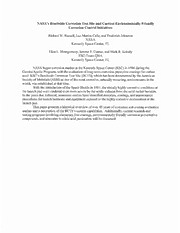
NASA Technical Reports Server (NTRS) 20130000806: NASA's Beachside Corrosion Test Site and Current Environmentally Friendly Corrosion Control Initiatives PDF
Preview NASA Technical Reports Server (NTRS) 20130000806: NASA's Beachside Corrosion Test Site and Current Environmentally Friendly Corrosion Control Initiatives
NASA's Beachside Corrosion Test Site and Current Environmentally Friendly Corrosion Control Initiatives Richard W. Russell, Luz Marina Calle, and Frederick Johnston NASA Kennedy Space Center, FL Eliza L. Montgomery, Jerome P. Curran, and Mark R. Kolody ESC-Team QNA Kennedy Space Center, FL NASA began corrosion studies at the Kennedy Space Center (KSC) in 1966 during the Gemini/Apollo Programs with the evaluation of long-tenn corrosion protective coatings for carbon steel. KSC's Beachside Corrosion Test Site (BCTS), which has been documented by the American Society of Materials (ASM) as one of the most corrosive, naturally occurring, environments in the world, was established at that time. With the introduction of the Space Shuttle in 1981, the already highly corrosive conditions at the launch pad were rendered even more severe by the acidic exhaust from the solid rocket boosters. In the years that followed, numerous studies have identified materials, coatings, and maintenance procedures for launch hardware and equipment exposed to the highly corrosive environment at the launch pad. This paper presents a historical overview of over 45 years of corrosion and coating evaluation studies and a description of the BCTS's current capabilities. Additionally, current research and testing programs involving chromium free coatings, environmentally friendly corrosion preventative compounds, and alternates to nitric acid passivation will be discussed.
